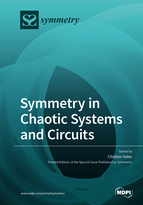Symmetry in Chaotic Systems and Circuits
A special issue of Symmetry (ISSN 2073-8994). This special issue belongs to the section "Computer".
Deadline for manuscript submissions: closed (30 September 2020) | Viewed by 38515
Special Issue Editor
Interests: electrical and electronics engineering; mathematical modeling; control theory; engineering, applied and computational mathematics; numerical analysis; mathematical analysis; numerical modeling; modeling and simulation; robotics
Special Issues, Collections and Topics in MDPI journals
Special Issue Information
Dear Colleagues,
Chaos theory is one of the most fascinating fields in modern science, revolutionizing our understanding of order and pattern in nature. Symmetry, a traditional and highly developed area of mathematics, would seem to lie at the opposite end of the spectrum. However, in the last few years, scientists have found connections between these two areas, connections which can have profound consequences for our understanding of the complex behavior in many physical, chemical, biological, and mechanical chaotic systems.
Therefore, symmetry can play an important role in the field of nonlinear systems and especially in the field of designing nonlinear circuits that produce chaos. In more detail, from designing chaotic systems and circuits with symmetric nonlinear terms to the study of system’s equilibria with symmetry in the case of self-excited attractors or symmetric line of equilibria in the case of hidden attractors, the feature of symmetry can play significant role in this kind of systems.
The aim of this Special Issue is to collect contributions in nonlinear chaotic systems and circuits that present as special a kind of symmetries as the aforementioned. Applications of chaotic systems and circuits where symmetry, or the deliberate lack of symmetry, is present, are also welcome.
Prof. Dr. Christos Volos
Guest Editor
Manuscript Submission Information
Manuscripts should be submitted online at www.mdpi.com by registering and logging in to this website. Once you are registered, click here to go to the submission form. Manuscripts can be submitted until the deadline. All submissions that pass pre-check are peer-reviewed. Accepted papers will be published continuously in the journal (as soon as accepted) and will be listed together on the special issue website. Research articles, review articles as well as short communications are invited. For planned papers, a title and short abstract (about 100 words) can be sent to the Editorial Office for announcement on this website.
Submitted manuscripts should not have been published previously, nor be under consideration for publication elsewhere (except conference proceedings papers). All manuscripts are thoroughly refereed through a single-blind peer-review process. A guide for authors and other relevant information for submission of manuscripts is available on the Instructions for Authors page. Symmetry is an international peer-reviewed open access monthly journal published by MDPI.
Please visit the Instructions for Authors page before submitting a manuscript. The Article Processing Charge (APC) for publication in this open access journal is 2400 CHF (Swiss Francs). Submitted papers should be well formatted and use good English. Authors may use MDPI's English editing service prior to publication or during author revisions.
Keywords
- chaos
- nonlinear systems
- nonlinear circuits
- control
- synchronization
- symmetric nonlinearities
- self-excited attractors
- hidden attractors
- applications of chaotic systems and circuits with symmetries






